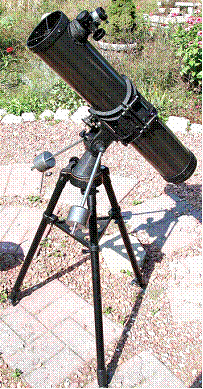A Case Study on Cheap Telescopes
Jack Kramer
A friend of ours thought it would be fun to have a telescope for some casual looks at objects in the sky. He had bought one through the Home Shopping Network several years ago, but his problem was "I could never see anything in it". So he asked me to take a look at it. Right away I had some idea what he was up against. It's a very bad idea to buy a telescope from either eBay or the Home Shopping Network. He may have been enticed by the nice case that was included, plus a CD with a planetarium program.
The telescope turned out to be a Galileo brand 4-inch f/9 Newtonian on an altazimuth mount. My impression is that this was designed by someone who had never used a telescope! It had one of the weirdest mounts I had ever seen, with two counterweights angling out from the altitude pivot. This did keep the telescope pretty well balanced at different altitude positions, but as every telescope maker knows, any time you have counterweights hanging off a mounting, you are asking for vibrations to be induced. To say the least, there are a lot better altazimuth designs. The flimsy tripod legs also contributed to a very bad case of the jiggles. Built into the tripod head is a compass ... as if it were needed on an altazimuth mount. As is customary for these types of scopes, many of the parts are made of plastic. There are slow motion controls on both axes, which have a lot of slop, but do work. Despite trying various adjustments, I could not get the focuser to operate smoothly.
 The first thing I did was check the collimation, which proved to be only slightly off. The mirror does have a center dot, which was a pleasant surprise. The owners manual has no information on how to collimate, other than to note simply that "the dot is for optical alignment and is not a defect". Period. What made the collimation difficult was that the locking screws destroyed the collimation, rather than simply holding the mirror in position. In the end, I adjusted the collimation screws, which seemed to be spring loaded, but didn't tighten the locking screws all the way. Clearly, this would be a source of frustration for the inexperienced user for whom this telescope is intended.
The first thing I did was check the collimation, which proved to be only slightly off. The mirror does have a center dot, which was a pleasant surprise. The owners manual has no information on how to collimate, other than to note simply that "the dot is for optical alignment and is not a defect". Period. What made the collimation difficult was that the locking screws destroyed the collimation, rather than simply holding the mirror in position. In the end, I adjusted the collimation screws, which seemed to be spring loaded, but didn't tighten the locking screws all the way. Clearly, this would be a source of frustration for the inexperienced user for whom this telescope is intended.
The next step was to line up the red dot finder. The instructions said to do this during the daytime, except for the fact that the red dot proved to be invisible during daylight hours! The next step was to see if this scope actually works. Surprisingly, the eyepieces are of the 11/4 inch format, though they are of typically poor quality. There is a 20mm Huygenian-Ramsden, a 6.8mm to 16mm zoom, and a 3x Barlow. They all have narrow fields of view, off-axis coma, chromatic aberration, and impart a slightly yellowish tint. The scope includes a filter wheel with a clear opening, a "planet" filter and a "nebula" filter. I discovered that this filter wheel must be in place in order for the eyepieces to reach focus. Of course, that fact wasn't specified in the manual.
As a first test, I homed in on Jupiter, which showed the four Galilean moons and two cloud belts. At least that's something! I tried the supplied "planet" filter, which gave Jupiter a strong yellow tinge and slightly improved the image in the included eyepieces, perhaps by masking the light thrown around by the chromatic aberration.
My own 12mm Orthoscopic eyepiece gave a much sharper and whiter image with a wider field of view ... clearly better than the eyepieces included with this scope. M22 was just a circular hazy spot. The next step was a star test of the primary mirror, which showed the mirror clips plus four heavy bars produced by the too-thick spider vanes. There was an Airy disk and clear concentric rings slightly flattened on one edge surrounding a mirror clip. This most likely was due to that clip holding the mirror too tightly. The image given by the primary was surprisingly good considering the other design and quality gaffs.
The reason our friend couldn't see anything in this scope may have been due to any number of issues, all of which contribute toward making this telescope unsuitable for anyone, but especially for the novice observer. The lack of a passable owners manual compounds the frustration. A decent telescope could be had for just a bit more than the cost of the Galileo. Buyer beware of this one!
Published in the December 2008 issue of the NightTimes




